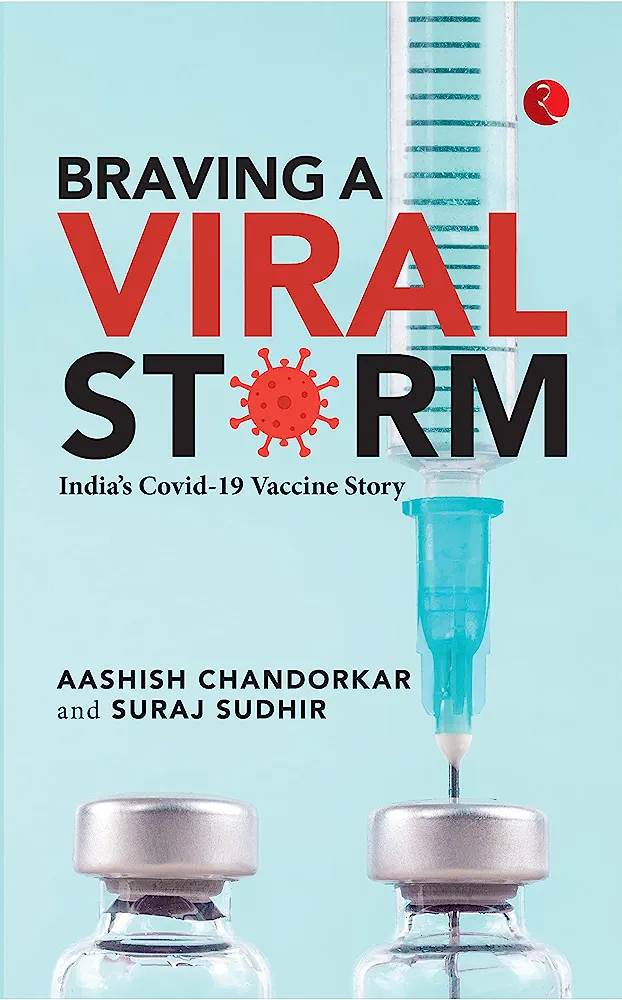
India’s Vaccination Drive: A Prompt Response to COVID-19
Behind the curtain explained by Aashish Chandorkar
- To begin with, during the pandemic’s initial phases when articles, research and content in general written about challenges, set back, and improvements how did you landed up in writing an appreciation?
The book Braving A Viral Storm focuses mainly on the vaccination part of the pandemic. Given the scale at which we delivered, leveraging indigenous capacities in every way possible, it would be hard for anyone to not accept – maybe grudgingly – that this program has achieved something special. It is good to reflect on what we achieve as a nation. Success is also an opportunity to learn because these ideas can be templatized to run even bigger missions. The book focuses on these successes – a wonderful mix of political leadership, scientific prowess, financial prudence and calibrated risk-taking, technology led delivery and of course people backing a collective national resolve.

- How is India’s story different than other nations’ story of vaccination drive?
The true import of the success of India’s vaccination program has been that the country was able to deliver on three As – Availability, Access and Affordability. For a country home to one-sixth of the global population, but barely $2,500 in per capita gross domestic product (GDP), this has been no mean feat. The journey from the anxiety and self-doubt of January 2021 to a comfortably-placed situation of socioeconomic was neither a given, not was facilitated by a ready playbook. Our scale and the delivery against that scale and complexity distinguishes us from other countries.
- In Indian scenario, why did the government took the full responsibility of distribution of vaccines?
Every person was equally susceptible to the virus. If the vaccines were left to market forces, we would have seen money and ability to influence doses prevail over the larger social good. Government could decide based on standard algorithms like the World Health Organization recommendations on which social group to vaccinate first. Left to private markets, the inequities of the society would have reflected in the vaccination program too. Left to states, there would have been a situation of governments going against their counterparts to get more and more doses of vaccines for themselves.
- Did active responses of the government made any specific difference that you have noticed while writing this book?
Oh absolutely – the program really required the government to play the very critical role of a catalyst. Let me give three examples.
First, India announced a vaccine research effort in the early days May 2020. This was before US, UK or EU put intent or money behind their efforts. Clearly, this made a huge difference in our context in development of Covaxin and then later several other vaccines got researched and produced in India.
Second, Prime Minister Modi held the first meeting on a potential technology-led delivery end of May 2020. Note that in May 2020, even the first wave had not fully played out. The government was already thinking vaccines and their digital administration. This made a huge difference in terms of how the health system approach the vaccination program.
Third, India supplied vaccines to almost 100 countries. This was a very active health and diplomatic engagement in the spirit of Vasudhaiv Kutumbakam.
- Many of us not know how did government mechanism worked for the vaccination drive, would you like to spill some parts of your book with our readers?
The key to the successful drive was very meticulous planning. India’s conscious efforts to create an National Empowered Group on Vaccination for example made sure that every aspect of the program was addressed.
For example, we think about vaccine availability, but generally speaking we would not think about the availability of needles, vials, vaccine storage equipment. Our detailed planning made sure that there was no shortage of these things. This is easy to miss when reflecting on the program. But behind this unsung success was very detailed planning and great coordination between various parts of the government.
- How do you see the private sector’s contribution on various fronts while tackling COVID-19?
India’s private sector played a huge role in this achievement. The most important aspect here was a very close public-private partnership. There was constant dialogue, there was an active response to the needs and asks of the private sector. On its part, the vaccine firms put in their money, effort and focus on both research as well as manufacturing. They worked through the pandemic creating safe working conditions in their factories. Some companies worked with scientists in the US and UK with digital collaboration. All of this is unheard of in pharmaceutical research and development. This collaboration between the private sector and the government in itself is something to templatize and apply to other critical areas important for the country.
- What were the biggest challenges in implementing this herculean vaccination drive?
This could be the topic of several articles perhaps! This would be a long list.
There was the challenge of belief to start off. Can we do this at all? Do we need help from others? Should we buy vaccines and not focus on making them? Are we really equipped as the western firms are? We saw these myths broken, but when these questions were being raised, it need a lot of political capital on part of the Prime Minister and the government to manage expectations.
There was the fiscal challenge. The government had to make sure that the economy is managing responsibly, where the growth bounces back. For this, vaccines were critical but also a big area of fiscal outlay. The balancing act posed key questions.
The regulators had to work closely the vaccine makers to make sure that safety and efficacy aspects were addressed. The clinical trials were done with great coordination between the regulators and the pharmaceutical firms. There was of course no guarantee that vaccines would have worked – not just in India but anywhere else too. So this was common concern for all regulators who were overseeing vaccine research and development.
Then the government had to look at the logistical complexities. Cold chains had to be ensured, vaccinators had to be trained, technology backbone had to be put in place for proper tracking and managing the proof of certification.
India like other countries also witnessed vaccine hesitancy. Specific efforts had to be made including clear communication strategies to make sure that people at large got the information they were looking for before making a decision to take the vaccine. In fact Prime Minister himself led the communication efforts including by his own actions like getting vaccinated publicly and then sharing that information with carefully chosen words.
And then of course we had to deal with India’s scale in every respect – population, size, geographical features, socioeconomic variations. These issues were all important inputs for the vaccination program design.
- To implement the vaccination policy, which areas or aspects have worked as a power house in the government mechanism?
While the entire program was special, I would say that having the CoWIN platform was simply amazing. This level of data visibility and organization is unprecedented. The level of transparency and trust this platform created went a long way in the success of the vaccination drive. It also led to better acceptance of the vaccine, helping every citizen view how the program was progressing around the country. It built peer-level awareness with excellent reporting. It helped instil a sense of pride and achievement too, that India can create a digital backbone of this sophistication and magnitude.
- India not only worked upon running an efficient vaccination policy but also helped other nations across the world by providing vaccines. As the Counsellor to Permanent Mission at World Trade Organization (WTO), Government of India, how do you see this fact changing the international relations?
India’s Vaccine Maitri program has been a huge winner. We supplied vaccines to countries who would not have been able to navigate through the complex web of global vaccine procurement competition. We also made these supplies concurrently with our own people getting vaccinated. We responded to the call of help. Beyond vaccines, India supplied medicines to 150+ countries. These actions have created tremendous goodwill for us. We saw visuals of how world leaders personally received consignments of vaccines at airports. It’s always a matter of great pride and a sense of national achievement when someone brings these stories up and recalls our contributions fondly.
- Can you share vital lessons that India has learned through this mighty exercise? How can India improve upon it?
In fact, the book covers this in great detail. The government is looking structural changes to be prepared if something similar happens in the future.
A National Institute of One Health is coming up in Nagpur, which will focus on research to understand diseases that can spread due to the interaction of humans, plants and animals and with the effects of climate change.
The National Institute of Virology Pune played a key role in managing the pandemic. The government is now looking to expand the number of such institutions around the country.
Platform like CoWIN has become a key advertisement for India’s Digital Public Infrastructure. There are efforts to take this infrastructure to other parts of the world.
India now has a huge vaccine manufacturing capacity upward of 4-billion doses. This is no mean feat as in times of any future crisis, India’s capacities can help the country and the world.
These are some of the key changes that we have witnessed.

Aashish Chandorkar
Mr. Ashish Chandorkar is presently working as the Counsellor to Permanent Mission of India at World Trade Organization, Geneva, Switzerland.Earlier, as an entrepreneur in the digital world, he helped build and scale these enablers for India's booming technology economy.He has 21 years of Management Consulting experience advising top tier clients across industries and geographies. He worked on advisory assignments with some of the large corporations globally.

